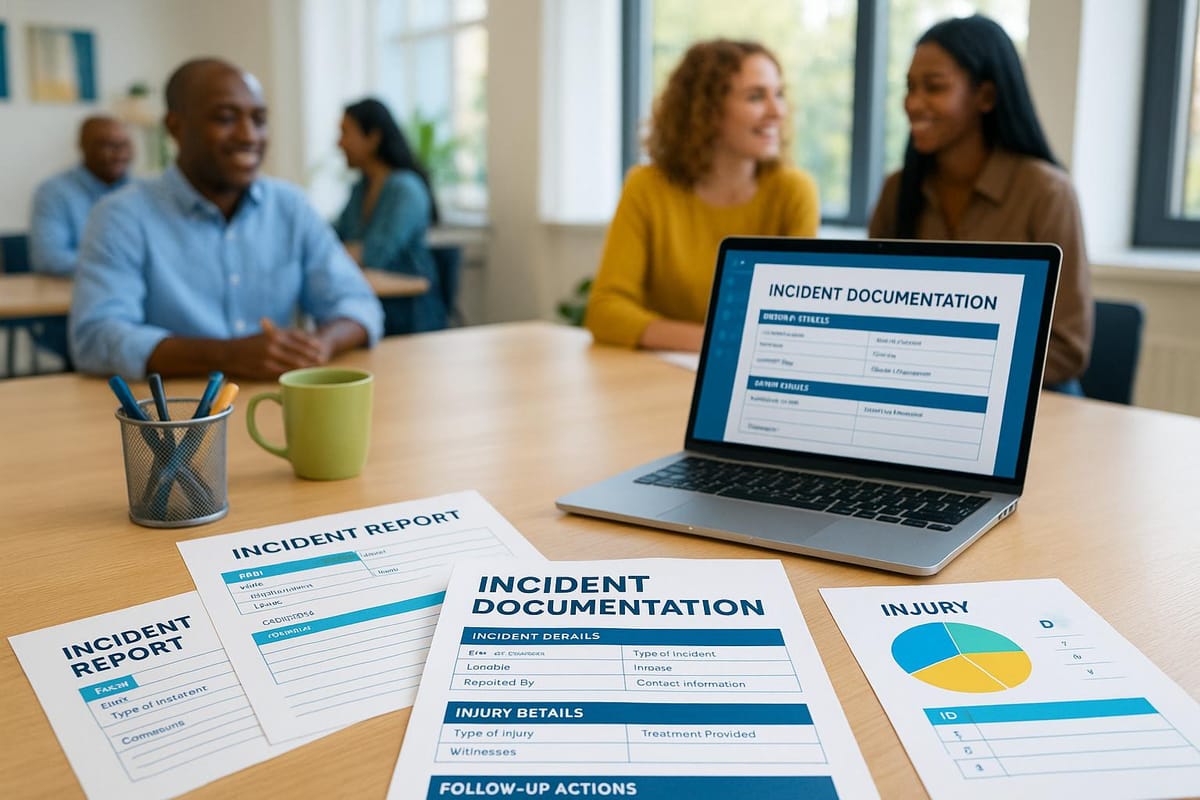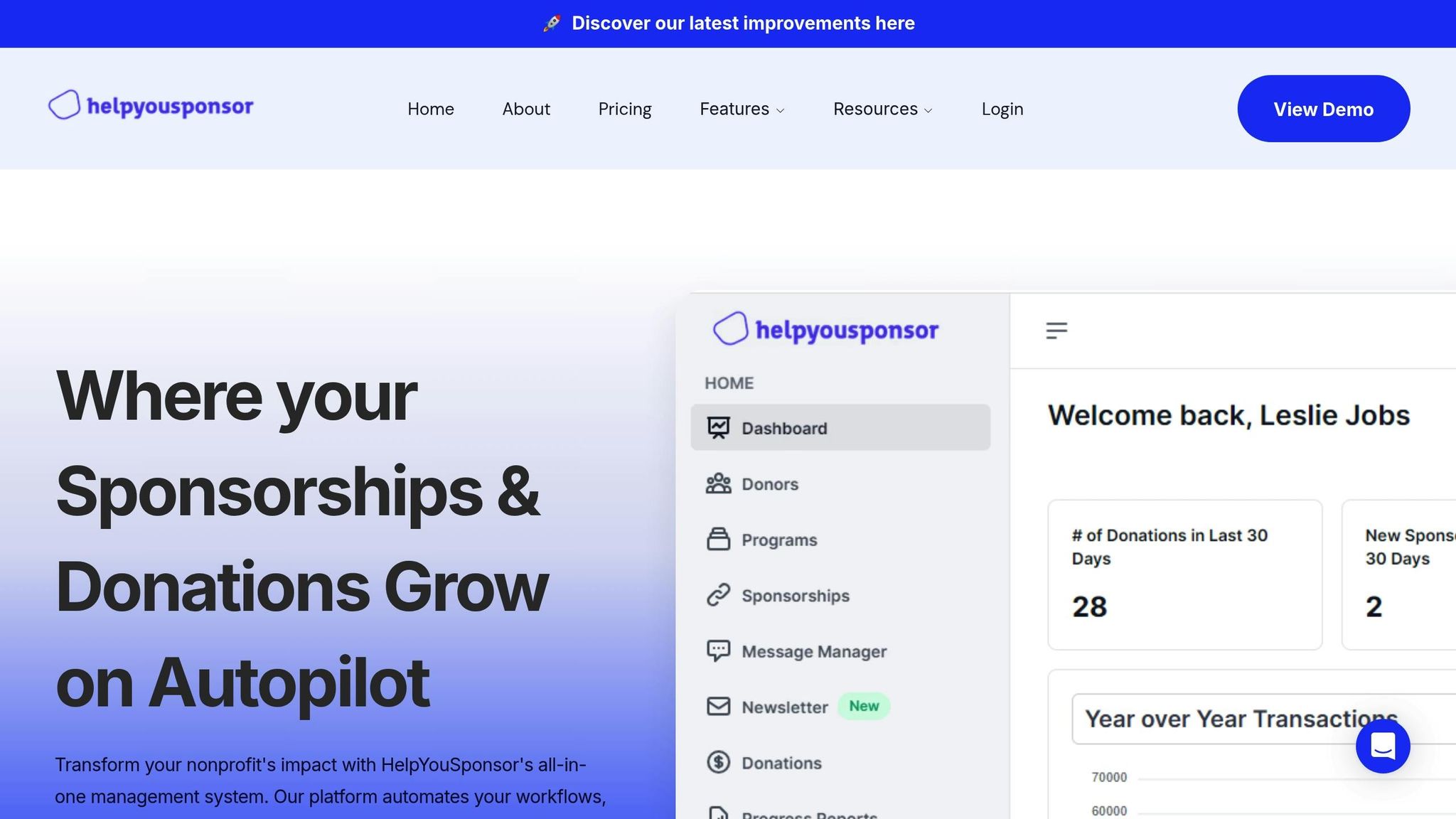Why Nonprofits Need Incident Documentation Templates
Effective incident documentation is crucial for nonprofits to mitigate risks, enhance safety, and ensure data security through standardized templates.

When nonprofits face incidents - like safety concerns, safeguarding issues, or data breaches - proper documentation is critical. Without it, organizations risk legal trouble, regulatory penalties, and damaged reputations. Templates simplify this process, ensuring consistent, secure, and efficient reporting. Here's why they matter:
- Protects Against Legal Risks: Accurate records provide evidence in disputes or audits.
- Improves Safeguarding: Helps identify patterns or trends that might signal deeper problems.
- Saves Time: Templates streamline reporting, reducing time spent on manual tasks.
- Ensures Data Security: Centralized, secure storage protects sensitive information.
- Boosts Trust: Transparent documentation reassures stakeholders and donors.
Create an Incident Report Template
Common Documentation Problems Nonprofits Face
Nonprofits often grapple with limited resources, outdated tools, and the complexities of managing large amounts of data. These hurdles manifest in issues like inconsistent reporting, time-intensive manual tasks, and challenges with secure data storage.
Inconsistent Reporting Standards
One of the biggest obstacles is the lack of uniform reporting practices across the organization. When staff and volunteers rely on different methods to document incidents, the resulting reports can become disjointed and nearly impossible to analyze. For instance, seasoned team members might assume certain safety measures are obvious, while newer staff or volunteers - due to inadequate training or unclear instructions - may miss critical hazards entirely.
Frequent staff turnover compounds the problem. With new hires constantly being onboarded, maintaining consistency in reporting becomes an uphill battle. This inconsistency leads to incomplete records and limits the ability to spot trends, which are crucial for preventing future incidents. Ultimately, these gaps weaken the effectiveness of safety protocols.
Time-Consuming Manual Processes
Manual documentation is another major pain point, especially for nonprofits already stretched thin. Writing a new report for every incident slows things down and increases the chances of missing key details. Staff often lose valuable time searching for, updating, or maintaining paper-based records. Hours spent digging through files could be better used elsewhere.
The complexity of manual processes can also discourage thorough reporting. When the system feels cumbersome, incidents may go unreported, leaving organizations with an incomplete picture of potential risks. Research highlights the financial benefits of improving these systems: nonprofits with formal incident response teams save nearly $500,000 on average when dealing with data breaches. Streamlining documentation isn’t just about efficiency - it’s a smart financial move.
Data Storage and Privacy Issues
Storing and managing sensitive data securely is a critical challenge for nonprofits. When audits or investigations require specific records, the inability to quickly retrieve them can slow down the process and leave gaps in documentation. This is especially problematic without digital systems in place, as staff often waste time sifting through physical files.
Beyond inefficiency, ensuring data security adds another layer of complexity. Keeping detailed records while safeguarding confidentiality is particularly vital when incidents involve minors or vulnerable populations. A data breach or privacy violation can severely damage an organization’s reputation and erode donor trust. In fact, 93% of nonprofits agree that a strong reputation directly impacts donor engagement.
Additionally, with 67% of nonprofit leaders acknowledging that mobile access has transformed their operations, documentation systems must be both secure and accessible. Staff working remotely or in the field need reliable tools to manage sensitive information without risking breaches. Poor data management not only threatens privacy but also undermines confidence in the organization’s ability to protect those it serves.
How Templates Fix These Documentation Problems
Nonprofits often face challenges with inconsistent documentation and security gaps, but standardized templates can help tackle these issues effectively. By introducing a clear structure and consistent approach, templates simplify processes and strengthen safeguards.
Standardized and Complete Reporting
Templates bring order to incident reporting by providing a structured format that ensures all essential details are recorded. When everyone uses the same format, reports become easier to compare, making it simpler to spot patterns or trends. With predefined fields - like date, time, involved parties, incident descriptions, and immediate actions - templates guide staff to include everything necessary without missing key details. Features like checkboxes and dropdown menus for common incident types or severity levels further reduce errors and miscommunication. This consistency not only improves accuracy but also saves time during daily operations.
Improved Efficiency and Time Savings
By standardizing reporting, templates significantly boost efficiency - especially for nonprofits operating with limited resources. Predefined fields eliminate the need to start from scratch for every report, cutting down on time spent. This streamlined approach minimizes discrepancies and makes data analysis easier, freeing up staff to focus on their core mission. For instance, a small business with 15 employees might spend around $2,000 annually on paper-related expenses. Nonprofits can redirect similar savings toward programs and community initiatives instead.
Enhanced Data Security and Compliance
Templates also play a key role in securing data and meeting privacy regulations. Trust is a major factor, with 88% of users basing their willingness to share personal information on how much they trust an organization, and 76% believing that companies need to do more to protect data online. Using standardized templates allows nonprofits to create privacy policies that align with regulations like the Colorado Privacy Act (CPA), California Consumer Privacy Act (CCPA), and Virginia Consumer Data Protection Act (VCDPA). These templates clearly outline what personal data is collected, how it’s used, and whether it’s shared with third parties. They also address security practices, data retention, cookie policies, and international data transfer clauses. With 33% of users ending relationships over privacy concerns and 92% of Americans expressing significant worries about online privacy, adopting templates for donor privacy policies is a critical step. This ensures personal and financial information is well-protected while staying compliant with data privacy and anti-spam laws.
Key Features of Good Incident Documentation Templates
Effective incident documentation templates do more than just record events - they create a solid foundation for quick responses and comprehensive future analysis. By organizing key details clearly and securely, these templates become essential tools for accountability and strategic decision-making.
Important Fields to Include in Templates
A well-rounded incident documentation template should cover the following critical fields to ensure no detail is overlooked:
- Basic Information: Include the date, time, location, and details about the person reporting the incident.
- Incident Description: Provide a detailed account of what occurred, outlining step-by-step actions and the overall impact.
- Witness Statements: Capture names, contact information, and firsthand observations from witnesses.
- Evidence Documentation: Log any physical, photographic, or digital evidence that supports the incident report.
- Actions Taken: Document immediate responses, follow-up actions, and identify the responsible parties for each step.
Each of these fields plays a pivotal role in painting a complete picture of the incident, ensuring clarity and accountability.
Digital Features for Modern Nonprofits
Digital platforms bring a new level of efficiency and security to incident documentation. Features like real-time collaboration, secure storage, and mobile accessibility make it easier for teams to update reports from anywhere. These tools also maintain a clear audit trail, ensuring transparency and accountability. Whether team members are working on-site or remotely, digital systems streamline the reporting process while keeping sensitive information safe.
Customization for Different Incident Types
One size doesn’t fit all when it comes to incident documentation. Templates should be flexible enough to address diverse types of incidents. Organizations can tweak the structure by adding or modifying fields to ensure every relevant detail is captured - whether for immediate action or long-term analysis. This adaptability ensures that the templates remain practical and effective across various situations.
Best Practices for Using Templates in Nonprofits
To make the most of standardized documentation, nonprofits need to adopt key strategies that align templates with organizational goals. By focusing on proper training, frequent updates, and centralized management, templates can become a vital tool for improving safety, transparency, and efficiency.
Staff Training and Policy Integration
Incorporating template use into your policies and training materials helps establish a culture where documentation becomes second nature. Update employee handbooks, volunteer guides, and training sessions with clear instructions on when and how to use each type of template. Emphasize that documentation is more than just paperwork - it’s a critical safeguard for everyone involved.
Staff should be trained to report incidents promptly and accurately, ensuring their accounts are factual, thorough, and free from bias or judgment. Leadership plays a crucial role here. When board members and senior leaders actively promote and participate in incident reporting processes, it sends a clear message: documentation is important. This leadership-driven approach fosters an environment where employees feel safe reporting incidents without fear of blame or retaliation.
Once staff are well-trained, the next step is to ensure templates stay relevant and up-to-date.
Regular Updates to Match Policy Changes
Templates should evolve alongside your organization’s policies, regulations, and emerging incident patterns. Regular reviews are essential to ensure they remain effective. Analyze recent incident reports to pinpoint gaps or recurring issues. For example, if certain fields are frequently left blank or staff consistently add notes about missing categories, it’s a sign your templates need adjustments.
Templates must also be adaptable to address specific incident types, legal requirements, or policy changes. Collaborate with your legal and compliance teams to ensure templates align with current regulations and organizational needs. This proactive approach minimizes risks and ensures your documentation stays relevant.
Centralized Platforms for Documentation Management
Storing incident reports in a centralized system enhances transparency, efficiency, and data security. When reports are scattered across multiple platforms - email accounts, physical files, or various systems - critical information can be lost, and patterns may go unnoticed.
Centralized systems address these challenges by providing secure access controls, audit trails, and real-time collaboration capabilities. This is especially helpful when urgent incidents require input from team members in different locations.
The benefits extend to governance as well. A study revealed that 58% of board members identified a need for improved digital oversight to enhance data management and accountability. Centralized systems enable better record-keeping, helping boards make informed decisions rather than relying on incomplete data or subjective judgment.
To implement centralized management effectively, establish consistent naming conventions and folder hierarchies. Create a structured system based on board functions, define user roles with clear permission levels, and conduct annual audits to maintain security and efficiency. Archiving materials after each board meeting ensures records remain organized and accessible.
Standardized templates, when paired with centralized storage, provide a systematic way to capture essential information. This combination not only improves clarity and accessibility but also helps identify trends, refine safety protocols, and demonstrate compliance during audits.
"Incident reporting data should inspire nonprofit leaders to improve operations, enhance safety, and detect harmful patterns before they escalate into accidents or ethical breaches". When reviewing incidents, focus on the harm or potential harm rather than assigning blame. Always tie the process back to your mission.
How HelpYouSponsor Helps with Incident Documentation

HelpYouSponsor isn’t just about managing sponsorships and donors - it also provides tools that make incident documentation more accurate and secure. By addressing common challenges nonprofits face, the platform offers a centralized and customizable approach to streamline the process. Let’s break down how HelpYouSponsor supports incident documentation.
Customizable Templates for Precise Reporting
With HelpYouSponsor’s custom form builder, organizations can create incident templates tailored to their exact needs. These templates ensure you capture all the necessary details, whether it’s related to volunteer incidents, beneficiary safety concerns, or financial irregularities.
Plus, you can add your organization’s logo and colors to the templates, making the process feel like a natural extension of your daily operations. This level of customization helps reinforce the importance of incident documentation within your team.
Secure and Centralized Record Storage
HelpYouSponsor provides a centralized storage solution designed specifically for sensitive incident reports. This means all your documentation is stored in one secure location, with access controls to ensure only authorized individuals can view or edit the records.
But it’s not just about security - having everything in one place also makes it easier to integrate incident documentation into your organization’s daily workflow.
Seamless Integration with Day-to-Day Operations
HelpYouSponsor takes things a step further by integrating incident documentation with your regular operations. For example, reports can be linked directly to donor profiles, so if an incident involves a sponsor or donor, all relevant information is connected in one system. No more switching between platforms or manually cross-referencing details.
The platform also connects with tools like Stripe, Mailchimp, and Zapier, making follow-up communications and workflows a breeze. Automated notifications ensure the right people are alerted when specific incidents are reported, so nothing falls through the cracks.
With nonprofits using HelpYouSponsor managing over $19 million in donations, the platform has proven its ability to handle large-scale operations. Organizations have even seen an average 3.8x increase in sponsorships after adopting HelpYouSponsor, showing how efficient systems can boost overall performance.
And the pricing? It’s designed to fit nonprofits of all sizes:
- Free Plan: Unlimited donors and up to 10 sponsorships per month.
- Pro Plan: $39/month.
- Max Plan: $0.50 per commitment.
Conclusion: Using Templates for Better Documentation
Incident documentation plays a vital role in protecting your nonprofit's mission and the people you serve. By adopting templates, you can transform disorganized reporting into a dependable system that saves time, minimizes mistakes, and bolsters safeguarding efforts. This structured approach helps lay the groundwork for stronger practices in protecting your organization and those it supports.
Templates bring consistency to the process by providing clear fields, naming conventions, and formatting rules. This uniformity is especially critical in nonprofit operations, where accuracy can directly influence safeguarding outcomes. When everyone follows the same guidelines, it’s easier to maintain high standards and avoid errors.
The benefits go beyond better reporting. Implementing proper documentation systems can lead to measurable improvements. For example, 58% of board members acknowledge the need for better digital tools to store and share data. A well-structured system not only meets this demand but also delivers operational efficiencies, allowing your organization to redirect resources toward its core mission.
However, success doesn’t happen automatically - it requires thoughtful implementation and regular updates. Start by defining clear templates with standardized fields and formatting. Train your team to use these tools effectively, and schedule periodic reviews to gather feedback and make necessary adjustments. Customizable policies also play a vital role, offering protection from legal or financial risks while promoting transparency with stakeholders.
As your organization evolves, so should your documentation system. Whether you’re beginning with simple templates or moving toward a fully integrated platform, investing in standardized, secure systems enhances efficiency, ensures compliance, and provides peace of mind for your team and stakeholders alike.
FAQs
How can nonprofits keep their incident documentation templates updated with changing regulations and policies?
To ensure your incident documentation templates stay relevant, nonprofits need to review and update them regularly to align with evolving laws, policies, and organizational priorities. Begin by comparing your current templates with new regulations and seek input from key stakeholders, like legal advisors or compliance professionals, to confirm they meet the latest standards.
Make these updates a part of your routine by scheduling regular reviews - whether quarterly or annually - and offering staff training on any changes. This proactive approach keeps your organization compliant and minimizes the risk of using outdated templates.
What are the benefits of using digital tools for incident documentation in nonprofits compared to traditional paper methods?
Switching to digital tools for incident documentation offers nonprofits a range of benefits that paper-based methods simply can't match. For starters, digital platforms enable quicker data entry and submission, which helps reduce delays and boosts responsiveness. Plus, they improve accuracy and security, cutting down on errors and keeping sensitive information protected.
Another big advantage is remote access and real-time monitoring. Teams can stay connected, share updates instantly, and collaborate more effectively, no matter where they are. These tools also lighten the load of administrative tasks, allowing nonprofits to direct more energy and resources toward their mission while maintaining transparency and compliance. The result? Day-to-day operations become far more streamlined and efficient.
How can incident documentation templates help nonprofits build trust with donors and stakeholders?
Incident documentation templates are essential tools for nonprofits aiming to maintain openness and responsibility. These templates provide a consistent way to record incidents, offering stakeholders clear evidence that your organization handles challenges with care and communicates honestly.
When nonprofits take the initiative to document and address issues thoroughly, they showcase a dedication to ethical standards and sound management. This approach not only boosts credibility but also builds lasting trust with donors and stakeholders, ultimately reinforcing support for your organization's mission.

